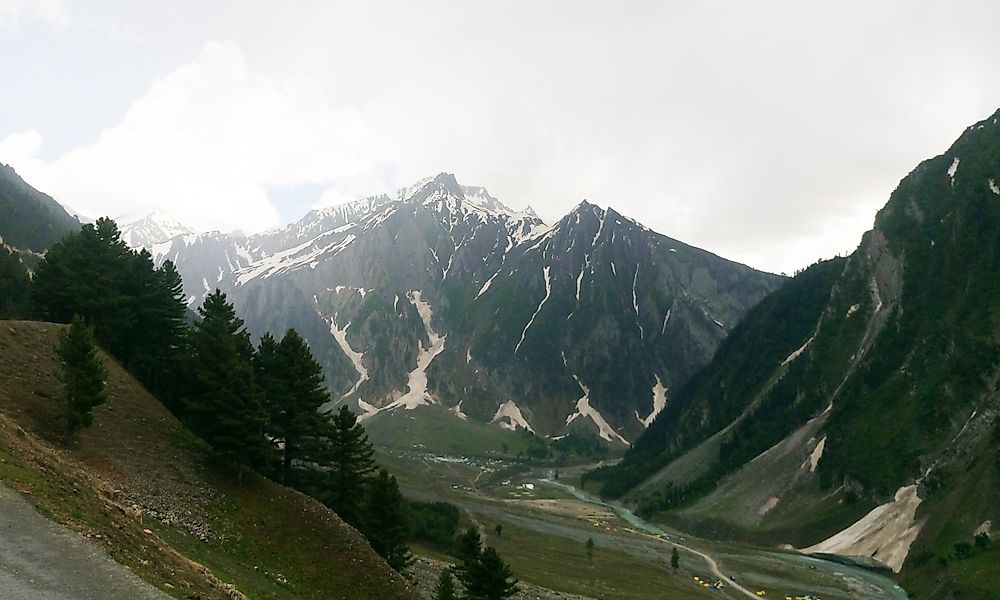The Different Types of Lacustrine Landforms on Earth

The term lacustrine means ‘relating to or associated with lakes.’ Thus, lacustrine landforms are natural features on the Earth’s surface that are related to lakes. Salt pans, beaches, and lacustrine terraces are examples of lacustrine landforms. These examples are described in further detail below.
Salt Pan
A salt pan is a massive area covered with salt and other minerals. Salt pans usually glisten white in the sunlight and are more common in desert areas. Such salt deposits are the result of evaporation of water from lakes or ponds. In desert areas, the rate of evaporation generally exceeds the rate of precipitation. Such conditions are ideal for the formation of salt pans. When water is unable to enter the ground, it remains on the surface to form lakes and ponds. However, when this water evaporates, sediment remains on the floor of such water bodies. Salt pans are very dangerous since they often hide a quagmire of mud underneath the salt crust. Such places can engulf large objects including trucks. The Sahara Desert’s Qattara Depression is an example of a dangerous salt pan that prevented invasions during World War II.
Lacustrine Plain
Also known as a lake plain, a lacustrine plain is formed when a lake is filled with incoming sediments. Over time, the lake loses its water due to geophysical processes like evaporation or drainage, and leaves behind a plain. Depending on the nature of the sediments forming the lacustrine plain, it can be used for agricultural purposes or discarded as desert land or wetland. The Kashmir Valley of India is an example of a lacustrine plain.
Lacustrine Terrace
A lacustrine terrace is a naturally occurring terraced landscape that is formed by the erosion or abrasion of sediments found on the shoreline of the lake, or in rare cases the bottom of the lake. Given the small size of lakes in comparison to oceans and seas, lacustrine terraces are less developed and narrower than marine terraces.
Oxbow Lake
An oxbow lake is an interesting lacustrine landform that is formed in places where a river meanders. Such lakes are U-shaped and are formed when the meander of a river is cut off from the main stem of the river. Deposition of sediments at the neck of the meander cuts it off from the rest of the river, and results in the formation of a standing water body. Oxbow lakes are usually formed at the lower courses of rivers, since meanders are often formed in such areas. Carter Lake in Iowa, USA is an example of an oxbow lake.
Oasis
An oasis can also be referred to as a lacustrine landform if it occurs in a desert surrounding a lake. The size of oases varies widely, and they may support plant growth if there is a continuous supply of freshwater from underground rivers of aquifers. Often human-made wells dug in the ground let out groundwater on the surface to form an oasis. Crops like dates, figs, or olives are grown in such oases. In many of the world's vast deserts, oases are the only areas hosting permanent settlements as they provide livable conditions for humans throughout the year.
Dry Lake
A dry lake, as the name suggests, is simply a depression or basin that was once filled with a standing body of water but is now dry. Such lakes are formed when the rate of evaporation is higher than the recharge of water in the lake. Dry lakes with salt deposits covering the lakebed are called salt flats. Dry lakes are very common in the eastern New Mexico, USA. Such lakes usually hold shallow water during the rainy season.
Endorheic Basin
An endorheic basin or closed basin is a drainage basin without an outlet. The water balance in such basins is maintained by the processes of evaporation and precipitation. In some cases, water also drains underground. The Caspian Sea, which is Earth’s largest lake, is an endorheic basin.
Beach of a Lake
Like the sea, a lake can also have beaches which exist alongside the lake and are made of loose particles like sand, pebbles, shingle, or gravel. Beaches are formed due to wave or current action. The beaches of large lakes, like those of Canada's Lake Ontario, are popular recreational areas, and visitors enjoy swimming, sunbathing, and water sports.











